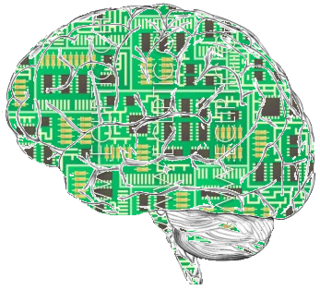Related Research Articles

Stanisław Herman Lem was a Polish writer of science fiction and essays on various subjects, including philosophy, futurology, and literary criticism. Many of his science fiction stories are of satirical and humorous character. Lem's books have been translated into more than 50 languages and have sold more than 45 million copies. Worldwide, he is best known as the author of the 1961 novel Solaris. In 1976 Theodore Sturgeon wrote that Lem was the most widely read science fiction writer in the world.

Mind uploading is a speculative process of whole brain emulation in which a brain scan is used to completely emulate the mental state of the individual in a digital computer. The computer would then run a simulation of the brain's information processing, such that it would respond in essentially the same way as the original brain and experience having a sentient conscious mind.

The Futurological Congress is a 1971 black humour science fiction novel by Polish author Stanisław Lem. It details the exploits of the hero of a number of his stories, Ijon Tichy, as he visits the Eighth World Futurological Congress at a Hilton Hotel in Costa Rica. The book is Lem's take on the science fictional trope of an apparently Utopian future that turns out to be an illusion.

Permutation City is a 1994 science-fiction novel by Greg Egan that explores many concepts, including quantum ontology, through various philosophical aspects of artificial life and simulated reality. Sections of the story were adapted from Egan's 1992 short story "Dust", which dealt with many of the same philosophical themes. Permutation City won the John W. Campbell Award for the best science-fiction novel of the year in 1995 and was nominated for the Philip K. Dick Award the same year. The novel was also cited in a 2003 Scientific American article on multiverses by Max Tegmark.

Observation on the Spot is a social science fiction novel by Stanisław Lem. The novel is a report of Ijon Tichy's travel to a faraway planet Entia to study their civilization. This report was supposed to fix a misunderstanding arisen from Tichy's Fourteenth Voyage to supposedly Entia, which turned out to be a satellite of Entia, masqueraded by Entians to misguide explorers. The travel was also to verify the results of the "Institute of Historiographical Computers", which use predictive modeling to overcome the speed of light limitation and get information about the state of the affairs on remote planets based on information obtained from previous expeditions.

Peace on Earth is a 1985 science fiction novel by Polish writer Stanisław Lem. The novel describes, in a satirical tone, the ultimate implications of the arms race. It is a continuation of the adventures of Ijon Tichy.
Ijon Tichy is a fictional character who appears in several works of the Polish science fiction writer Stanisław Lem: initially in The Star Diaries, later in The Futurological Congress, Peace on Earth, Observation on the Spot, and Memoirs of a Space Traveller. Tichy is also the narrator in a 1973 novel Professor A. Dońda, being the professor's sidekick.

Simulacron-3 (1964), by Daniel F. Galouye, is an American science fiction novel featuring an early literary description of a simulated reality.

Mind uploading—transferring an individual's personality to a computer—appears in several works of fiction. It is distinct from the concept of transferring a consciousness from one human body to another. It is sometimes applied to a single person and other times to an entire society. Recurring themes in these stories include whether the computerized mind is truly conscious, and if so, whether identity is preserved. It is a common feature of the cyberpunk subgenre, sometimes taking the form of digital immortality.

The simulation hypothesis proposes that what humans experience as the world is actually a simulated reality, such as a computer simulation in which humans themselves are constructs. There has been much debate over this topic, ranging from philosophical discourse to practical applications in computing.

Professor Tarantoga, an eccentric xenozoologist, traveller, and inventor, is a fictional character from science fiction works, mostly humorous, by Polish writer Stanislaw Lem.
Ijon Tichy: Space Pilot is a satiric German television series loosely based on the series of science fiction stories The Star Diaries by Stanisław Lem. The television series was created by Randa Chahoud, Dennis Jacobsen, and Oliver Jahn with Jahn playing the protagonist, space traveller Ijon Tichy. The major female role, the female robot hologramme, is played by Nora Tschirner.
Sepulkas, are fictional objects found in works The Star Diaries and Observation on the Spot, Stanisław Lem. A fictional encyclopedia lists them as "objects used for sepuling".
Mad scientists and inventors appear in the fiction of Stanisław Lem in the memoirs of Lem's starfaring vagabond Ijon Tichy, collected in The Star Diaries and Memoirs of a Space Traveller, as well as in The Cyberiad. Most of Lem's mad scientist stories fit into the format of stories about unusual inventions, known since the 19th century, most of them are devoid of ironic tone characteristic of most of Ijon Tichy's stories and robots' fables, and they are literary frames for various Lem's theories.
Virtual reality in fiction describes fictional representations of the technological concept of virtual reality.

The Mask is a science fiction techno horror short story by Polish writer Stanisław Lem written in 1974 and first published in literary magazine Kultura that year. It was the title story in a short story collection published in 1976 by Wydawnictwo Literackie. It is a story of an assassin android she-robot programmed both to love and to kill its human target and who gradually becomes aware of herself and her programming.
Professor A. Dońda (Polish: Profesor A. Dońda is a satirical apocalyptic science fiction novelette by Polish writer Stanisław Lem. It was first published in a satirical magazine Szpilki in 1973 and later republished in several collections and anthologies.
"Lymphater's Formula" is a 1961 science fiction short story by Polish writer Stanisław Lem. It is a story of a "mad scientist", mathematician Ammon Lymphater, who invents an artificial intelligence, and then he realizes that it is capable of rendering the humankind obsolete.
References
- ↑ Lem, Stanislaw (1 February 2000). Memoirs of a Space Traveler: Further Reminiscences of Ijon Tichy. Northwestern University Press. p. 39. ISBN 978-0-8101-1732-7 . Retrieved 29 July 2013.
- ↑ Swirski, Peter (27 July 2006). The Art and Science of Stanislaw Lem. McGill-Queen's Press. p. 118. ISBN 978-0-7735-7507-3 . Retrieved 29 July 2013.
- ↑ Stratmann, H. G. (2015). Using Medicine in Science Fiction: The SF Writer's Guide to Human Biology. Springer. p. 493. ISBN 978-3-319-16015-3.
- ↑ Garner, Tom A. (2017). Echoes of Other Worlds: Sound in Virtual Reality: Past, Present and Future. Springer. p. 141. ISBN 978-3-319-65708-0.
- ↑ "An Interview With Greg Egan | Counting Backwards From Infinity". Eidolon Magazine. 15: 42–45. July 1994. Retrieved 27 July 2018.